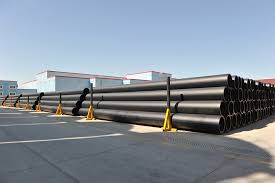Aug . 29, 2024 05:31 Back to list
HDPE Pipe Diameters Manufacturer - Quality HDPE Pipes for Every Application
Understanding HDPE Pipe Diameters and Their Manufacturers
High-Density Polyethylene (HDPE) pipes have become a standard choice in various applications due to their robust properties, corrosion resistance, and flexibility
. As industries continue to embrace sustainable materials, understanding HDPE pipe diameters and selecting the right manufacturer is crucial for ensuring optimal performance and longevity.HDPE pipes come in a range of diameters, typically measured in either nominal sizes or specific dimensions. Common nominal sizes vary from ½ inch to several feet in diameter, catering to diverse needs in agricultural, construction, water distribution, and wastewater management sectors. The size chosen often depends on the intended application, the flow requirements, and the operational pressure.
Manufacturers of HDPE pipes employ specific methods to create these diameters, ensuring that each pipe meets industry standards. The dimensions of HDPE pipes are often represented in nominal pipe size (NPS) and outside diameter (OD). For instance, a 4-inch NPS HDPE pipe has an actual OD of approximately 4.5 inches. It is essential for customers to understand both the nominal sizes and the actual measurements to ensure compatibility with existing piping systems.
One of the significant advantages of HDPE pipes is their lightweight nature, allowing for easy handling and installation, especially in larger diameters. This lightweight characteristic translates directly to lower transportation costs and simplifies logistics. Consequently, choosing a reliable manufacturer that offers a wide range of diameters ensures that users can find the exact specifications required for their projects.
hdpe pipe diameters manufacturer

When selecting a manufacturer, quality assurance is vital. The manufacturer should comply with industry standards, such as those set by the American Society for Testing and Materials (ASTM) and the American Water Works Association (AWWA). An ISO-certified manufacturer demonstrates a commitment to quality and consistency, which is crucial for maintaining the integrity of HDPE piping systems over time.
In addition to compliance, manufacturers often provide technical support and resources. This includes guidance on how to choose the right pipe diameter based on project specifications, installation techniques, and general best practices. A proactive manufacturer will also offer warranties and guarantees, giving customers peace of mind regarding their investment.
Furthermore, the sustainability aspect of HDPE cannot be overlooked. These pipes are typically produced from recycled materials, reducing environmental impact while promoting a circular economy. As governments and corporations prioritize sustainable practices, the demand for HDPE pipes continues to surge. Understanding the sizes offered and the range of suppliers available can help consumers make informed decisions aligned with eco-friendly initiatives.
In conclusion, the range of HDPE pipe diameters available in the market caters to various industrial needs, with manufacturers playing a pivotal role in ensuring quality and compliance. By selecting the right diameter and a reputable manufacturer, businesses can achieve efficient and sustainable solutions for their piping requirements. As the industry evolves, staying informed about diameter specifications and manufacturer capabilities remains essential for achieving long-lasting, effective results in any project involving HDPE pipes.
-
High-Quality PVC Borehole Pipes Durable & Versatile Pipe Solutions
NewsJul.08,2025
-
High-Quality PVC Perforated Pipes for Efficient Drainage Leading Manufacturers & Factories
NewsJul.08,2025
-
High-Quality PVC Borehole Pipes Durable Pipe Solutions by Leading Manufacturer
NewsJul.08,2025
-
High-Quality PVC Borehole Pipes Reliable PVC Pipe Manufacturer Solutions
NewsJul.07,2025
-
High-Quality UPVC Drain Pipes Durable HDPE & Drain Pipe Solutions
NewsJul.07,2025
-
High-Quality Conduit Pipes & HDPE Conduit Fittings Manufacturer Reliable Factory Supply
NewsJul.06,2025

